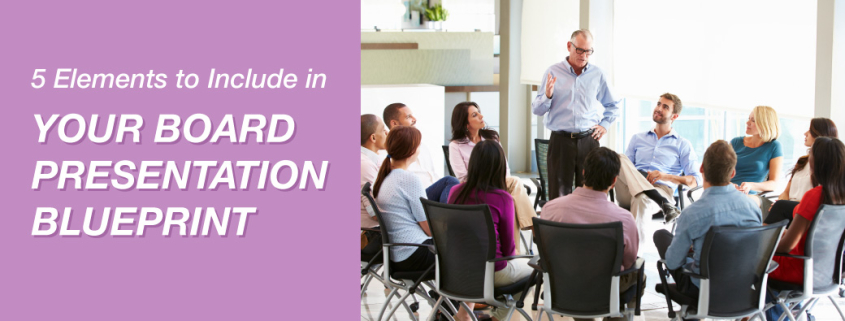5 Elements to Include in Your Board Presentation Blueprint
Board members play an essential role in your organization. They set your strategic goals, provide oversight, and make key decisions to improve your fundraising and donor stewardship efforts.
When you present to board members, you don’t have any time to waste. Your presentations should include all the must-have information board members need to fulfill their roles successfully, along with meaningful moments that help them feel more connected to your mission.
Carefully planning your board meeting presentations is an essential presentation skill that can make your gatherings more productive and collaborative.
Here are the five must-have elements for your board presentation plan:
1. A presentation storyboard
Be Brilliant Presentation Group recommends planning your presentation using the Be Brilliant Blueprint. Part of the Blueprint involves storyboarding your presentation.
In the storyboarding phase, you’ll outline the basics of your presentation on paper. This ensures that you don’t get distracted by building the digital elements of your presentation before you’ve nailed down the content.
As you plan your presentation, note the main topics you’d like to focus on, areas where you need input or approval from board members, and the main takeaway you’d like board members to leave the meeting with.
2. Interactive moments
You may be wondering how to write a presentation that not only keeps board members informed but also engaged in your content. The answer lies in providing several interactive moments.
As you storyboard your presentation, include interactive elements like:
- Group brainstorming. Board members can provide useful insight if your nonprofit is facing a challenge or presented with a new opportunity. Set aside a few minutes to allow board members to discuss as a full board or meet in small groups to come up with ideas to take on these opportunities effectively.
- A Q&A session. If you’re presenting on a more technical topic, allow board members to ask questions in an open-format Q&A. Note any questions for which you don’t have immediate answers and follow up with board members after the meeting.
- Sharing a mission-related moment. According to NXUnite, board members are essential for helping your nonprofit market its mission to a wider audience. Consider taking 5-10 minutes in your meeting to allow board members to share a recent moment when they felt particularly connected to your mission. This exercise can help everyone think about their personal connection to your cause, giving them talking points to bring up when promoting your nonprofit to a wider audience.
Some of the best ideas arise from impromptu conversations and brainstorming sessions during board meetings. These moments will help board members feel more connected to your mission and more engaged in their roles.
3. Campaign updates
Provide board members with any updates about your organization’s current campaigns. Make sure board members are aware of the following aspect of your initiatives:
- Where donations are coming from. Who is giving and what platforms are they using to do so?
- Goal progress updates. How close are you to reaching your goal, and what is needed from board members to help get you there?
- Your donation request strategies. For example, are you sending gift request letters or emails? What are your response rates for these channels?
Be fully transparent with board members about your campaign’s successes and challenges. Invite board members to brainstorm ways to reach your goals more efficiently.
4. Essential metrics
You don’t need to walk board members through all the data your nonprofit collects. Keep the focus on just the need-to-know information.
For example, if you’re recapping the results of a recent peer-to-peer fundraising campaign, you might cover statistics such as:
- Cost per dollar raised
- Average donation amount
- The campaign’s donor retention rate
Present this information clearly and make sure to provide context as needed. For example, if your average donation amount is lower than expected, offer your assessment of why you think that’s the case and what your organization can do next time to correct the issue.
5. Donor stewardship update
Board members play a significant role in stewarding your organization’s supporters, such as major donors or corporate sponsors. Make sure your presentation plan includes updates on your nonprofit’s latest donor stewardship strategies.
For example:
- Are you using new donor recognition strategies, such as creating appreciation videos or handwritten letters?
- Are you trying a new email marketing platform that makes it easier to create targeted email campaigns?
- Are you looking for board members’ support in stewarding new major donor prospects?
- Have you recently seen a major uptick in responses to your direct mail outreach?
Take the opportunity to spotlight board members who have made positive contributions to your donor stewardship program. Thank them for their efforts and let other board members know how they can get more involved.
Board members need to know how your nonprofit is doing at any given time and where they can step in to assist. With a well-planned presentation, you can equip them with this need-to-know information quickly and efficiently, making the best use of everyone’s time. Reducing excess meeting time gives more time for board members to actually work on your nonprofit’s initiatives and push your mission forward.




